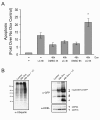Endoplasmic reticulum stress response in an INS-1 pancreatic beta-cell line with inducible expression of a folding-deficient proinsulin
- PMID: 20659334
- PMCID: PMC2921384
- DOI: 10.1186/1471-2121-11-59
Endoplasmic reticulum stress response in an INS-1 pancreatic beta-cell line with inducible expression of a folding-deficient proinsulin
Abstract
Background: Cells respond to endoplasmic reticulum stress (ER) stress by activating the unfolded protein response. To study the ER stress response in pancreatic beta-cells we developed a model system that allows for pathophysiological ER stress based on the Akita mouse. This mouse strain expresses a mutant insulin 2 gene (C96Y), which prevents normal proinsulin folding causing ER stress and eventual beta-cell apoptosis. A double-stable pancreatic beta-cell line (pTet-ON INS-1) with inducible expression of insulin 2 (C96Y) fused to EGFP was generated to study the ER stress response.
Results: Expression of Ins 2 (C96Y)-EGFP resulted in activation of the ER stress pathways (PERK, IRE1 and ATF6) and caused dilation of the ER. To identify gene expression changes resulting from mutant insulin expression we performed microarray expression profiling and real time PCR experiments. We observed an induction of various ER chaperone, co-chaperone and ER-associated degradation genes after 24 h and an increase in pro-apoptotic genes (Chop and Trib3) following 48 h of mutant insulin expression. The latter changes occurred at a time when general apoptosis was detected in the cell population, although the relative amount of cell death was low. Inhibiting the proteasome or depleting Herp protein expression increased mutant insulin levels and enhanced cell apoptosis, indicating that ER-associated degradation is maintaining cell survival.
Conclusions: The inducible mutant insulin expressing cell model has allowed for the identification of the ER stress response in beta-cells and the repertoire of genes/proteins induced is unique to this cell type. ER-associated degradation is essential in maintaining cell survival in cells expressing mutant insulin. This cell model will be useful for the molecular characterization of ER stress-induced genes.
Figures









Similar articles
-
IRE1 inhibition perturbs the unfolded protein response in a pancreatic β-cell line expressing mutant proinsulin, but does not sensitize the cells to apoptosis.BMC Cell Biol. 2014 Jul 10;15:29. doi: 10.1186/1471-2121-15-29. BMC Cell Biol. 2014. PMID: 25011481 Free PMC article.
-
Endoplasmic reticulum oxidoreductin-1α (Ero1α) improves folding and secretion of mutant proinsulin and limits mutant proinsulin-induced endoplasmic reticulum stress.J Biol Chem. 2013 Oct 25;288(43):31010-8. doi: 10.1074/jbc.M113.510065. Epub 2013 Sep 10. J Biol Chem. 2013. PMID: 24022479 Free PMC article.
-
SDF2L1 interacts with the ER-associated degradation machinery and retards the degradation of mutant proinsulin in pancreatic β-cells.J Cell Sci. 2013 May 1;126(Pt 9):1962-8. doi: 10.1242/jcs.117374. Epub 2013 Feb 26. J Cell Sci. 2013. PMID: 23444373
-
Proinsulin misfolding and endoplasmic reticulum stress during the development and progression of diabetes.Mol Aspects Med. 2015 Apr;42:105-18. doi: 10.1016/j.mam.2015.01.001. Epub 2015 Jan 8. Mol Aspects Med. 2015. PMID: 25579745 Free PMC article. Review.
-
Proinsulin entry and transit through the endoplasmic reticulum in pancreatic beta cells.Vitam Horm. 2014;95:35-62. doi: 10.1016/B978-0-12-800174-5.00002-8. Vitam Horm. 2014. PMID: 24559913 Review.
Cited by
-
Chaperoning Endoplasmic Reticulum-Associated Degradation (ERAD) and Protein Conformational Diseases.Cold Spring Harb Perspect Biol. 2019 Aug 1;11(8):a033928. doi: 10.1101/cshperspect.a033928. Cold Spring Harb Perspect Biol. 2019. PMID: 30670468 Free PMC article. Review.
-
Role of the unfolded protein response in β cell compensation and failure during diabetes.J Diabetes Res. 2014;2014:795171. doi: 10.1155/2014/795171. Epub 2014 Apr 9. J Diabetes Res. 2014. PMID: 24812634 Free PMC article. Review.
-
INS-gene mutations: from genetics and beta cell biology to clinical disease.Mol Aspects Med. 2015 Apr;42:3-18. doi: 10.1016/j.mam.2014.12.001. Epub 2014 Dec 24. Mol Aspects Med. 2015. PMID: 25542748 Free PMC article. Review.
-
TSG-6 secreted by human adipose tissue-derived mesenchymal stem cells ameliorates severe acute pancreatitis via ER stress downregulation in mice.Stem Cell Res Ther. 2018 Sep 26;9(1):255. doi: 10.1186/s13287-018-1009-8. Stem Cell Res Ther. 2018. PMID: 30257717 Free PMC article.
-
Insulin gene mutations and diabetes.J Diabetes Investig. 2011 Apr 7;2(2):92-100. doi: 10.1111/j.2040-1124.2011.00100.x. J Diabetes Investig. 2011. PMID: 24843467 Free PMC article. Review.
References
Publication types
MeSH terms
Substances
Grants and funding
LinkOut - more resources
Full Text Sources
Other Literature Sources
Medical
Molecular Biology Databases
Research Materials
Miscellaneous

